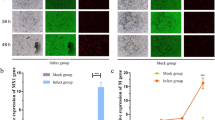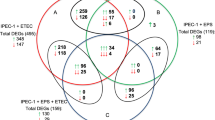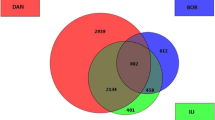Abstract
The local intestinal mucosa, the largest mucosal immune system in animals, plays an important role in resistance against intestinal pathogen infection. However, the molecular antiviral mechanisms of the intestinal mucosa remain poorly understood. In this study, we screened and identified differentially expressed transcripts in (PSV) porcine intestinal epithelial cells (IPEC-J2) infected with porcine sapelovirus using microarray analysis. A total of 2298 differentially expressed genes were screened at four time points during PSV infection. These genes were involved in numerous physical systems and molecular pathways, and particularly, some innate immune-associated pathways were significant. The results showed that large amounts of type I interferon were induced, and the related interferon effect pathway was activated when IPEC-J2 cells were infected with PSV. Three pathways of innate immune receptors, including Toll-like, NOD-like, and RIG-I-like receptors, were also activated. The antigen was then processed and presented through the MHCI and MHCII pathways. Interestingly, we found that the secretion network of IgA was activated in the early stage of PSV infection. Two exogenous and endogenous apoptosis pathways were also activated during PSV infection. The results revealed changes in gene transcription, particularly those of innate immune pathway genes that were associated with PSV infection in IPEC-J2 cells.



Similar content being viewed by others
References
Adams JM, Cory S (2007) Bcl-2-regulated apoptosis: mechanism and therapeutic potential. Curr Opinion Immunol 19:488–496
Alexopoulou L, Holt AC, Medzhitov R, Flavell RA (2001) Recognition of double-stranded RNA and activation of NF-kappaB by Toll-like receptor 3. Nature 413:732–738
Bailey M (2009) The mucosal immune system: recent developments and future directions in the pig. Dev Comp Immunol 33:375–383
Blondel B, Autret A, Brisac C, Martin-Latil S, Mousson L, Pelletier I, Estaquier J, Colbere-Garapin F (2009) Apoptotic signaling cascades operating in poliovirus-infected cells. Front Biosci J Virtual Libr 14:2181–2192
Brewer LA, Lwamba HC, Murtaugh MP, Palmenberg AC, Brown C, Njenga MK (2001) Porcine encephalomyocarditis virus persists in pig myocardium and infects human myocardial cells. J Virol 75:11621–11629
Buenz EJ, Howe CL (2006) Picornaviruses and cell death. Trends Microbiol 14:28–36
Chard LS, Bordeleau ME, Pelletier J, Tanaka J, Belsham GJ (2006) Hepatitis C virus-related internal ribosome entry sites are found in multiple genera of the family Picornaviridae. J Gen Virol 87:927–936
Chorny A, Puga I, Cerutti A (2010) Innate signaling networks in mucosal IgA class switching. Adv Immunol 107:31–69
Chou JJ, Li H, Salvesen GS, Yuan J, Wagner G (1999) Solution structure of BID, an intracellular amplifier of apoptotic signaling. Cell 96:615–624
Cui J, Zhu L, Xia X, Wang HY, Legras X, Hong J, Ji J, Shen P, Zheng S, Chen ZJ, Wang RF (2010) NLRC5 negatively regulates the NF-kappaB and type I interferon signaling pathways. Cell 141:483–496
Daidoji T, Koma T, Du A, Yang CS, Ueda M, Ikuta K, Nakaya T (2008) H5N1 avian influenza virus induces apoptotic cell death in mammalian airway epithelial cells. J Virol 82:11294–11307
Dash P, Barnett PV, Denyer MS, Jackson T, Stirling CM, Hawes PC, Simpson JL, Monaghan P, Takamatsu HH (2010) Foot-and-mouth disease virus replicates only transiently in well-differentiated porcine nasal epithelial cells. J Virol 84:9149–9160
Dziarski R (2003) Recognition of bacterial peptidoglycan by the innate immune system. Cellular Mol Life Sci (CMLS) 60:1793–1804
Eleouet JF, Chilmonczyk S, Besnardeau L, Laude H (1998) Transmissible gastroenteritis coronavirus induces programmed cell death in infected cells through a caspase-dependent pathway. J Virol 72:4918–4924
Finberg RW, Wang JP, Kurt-Jones EA (2007) Toll like receptors and viruses. Rev Med Virol 17:35–43
Fu ZF, Jackson AC (2005) Neuronal dysfunction and death in rabies virus infection. J Neurovirol 11:101–106
Furr SR, Chauhan VS, Sterka D Jr, Grdzelishvili V, Marriott I (2008) Characterization of retinoic acid-inducible gene-I expression in primary murine glia following exposure to vesicular stomatitis virus. J Neurovirol 14:503–513
Gerlier D, Valentin H (2009) Measles virus interaction with host cells and impact on innate immunity. Curr Top Microbiol Immunol 329:163–191
Ghiotto F, Fais F, Bruno S (2010) BH3-only proteins: the death-puppeteer’s wires. Cytometry Part A. J Int Soc Anal Cytol 77:11–21
Haller O, Kochs G (2011) Human MxA protein: an interferon-induced dynamin-like GTPase with broad antiviral activity. J Interf Cytokine Res: Off J Int Soc Interf Cytokine Res 31:79–87
Hayashi F, Smith KD, Ozinsky A, Hawn TR, Yi EC, Goodlett DR, Eng JK, Akira S, Underhill DM, Aderem A (2001) The innate immune response to bacterial flagellin is mediated by Toll-like receptor 5. Nature 410:1099–1103
Hecht G (1999) Innate mechanisms of epithelial host defense: spotlight on intestine. Am J Physiol 277:C351–C358
Hegde NR, Chevalier MS, Johnson DC (2003) Viral inhibition of MHC class II antigen presentation. Trends Immunol 24:278–285
Holmgren J, Czerkinsky C, Eriksson K, Mharandi A (2003) Mucosal immunisation and adjuvants: a brief overview of recent advances and challenges. Vaccine 21(Suppl 2):S89–S95
Kaku Y, Sarai A, Murakami Y (2001) Genetic reclassification of porcine enteroviruses. J Gen Virol 82:417–424
Kato H, Takeuchi O, Sato S, Yoneyama M, Yamamoto M, Matsui K, Uematsu S, Jung A, Kawai T, Ishii KJ, Yamaguchi O, Otsu K, Tsujimura T, Koh CS, Reis e Sousa C, Matsuura Y, Fujita T, Akira S (2006) Differential roles of MDA5 and RIG-I helicases in the recognition of RNA viruses. Nature 441:101–105
Krumbholz A, Dauber M, Henke A, Birch-Hirschfeld E, Knowles NJ, Stelzner A, Zell R (2002) Sequencing of porcine enterovirus groups II and III reveals unique features of both virus groups. J Virol 76:5813–5821
Ku BK, Kim SB, Moon OK, Lee SJ, Lee JH, Lyoo YS, Kim HJ, Sur JH (2005) Role of apoptosis in the pathogenesis of Asian and South American foot-and-mouth disease viruses in swine. J Vet Med Sci/Jpn Soc Vet Sci 67:1081–1088
Lamkanfi M, Kanneganti TD (2012) Regulation of immune pathways by the NOD-like receptor NLRC5. Immunobiology 217:13–16
Lan D, Ji W, Yang S, Cui L, Yang Z, Yuan C, Hua X (2011) Isolation and characterization of the first Chinese porcine sapelovirus strain. Arch Virol 156:1567–1574
Le Goffic R, Pothlichet J, Vitour D, Fujita T, Meurs E, Chignard M, Si-Tahar M (2007) Cutting Edge: Influenza A virus activates TLR3-dependent inflammatory and RIG-I-dependent antiviral responses in human lung epithelial cells. J Immunol 178:3368–3372
Lin CH, Shih WL, Lin FL, Hsieh YC, Kuo YR, Liao MH, Liu HJ (2009) Bovine ephemeral fever virus-induced apoptosis requires virus gene expression and activation of Fas and mitochondrial signaling pathway. Apoptosis: Int J Progr Cell Death 14:864–877
Ling Z, Tran KC, Teng MN (2009) Human respiratory syncytial virus nonstructural protein NS2 antagonizes the activation of beta interferon transcription by interacting with RIG-I. J Virol 83:3734–3742
Liu Y, Zhang X (2007) Murine coronavirus-induced oligodendrocyte apoptosis is mediated through the activation of the Fas signaling pathway. Virology 360:364–375
MacMicking JD (2004) IFN-inducible GTPases and immunity to intracellular pathogens. Trends Immunol 25:601–609
Macpherson AJ, McCoy KD, Johansen FE, Brandtzaeg P (2008) The immune geography of IgA induction and function. Mucosal Immunol 1:11–22
Marques R, Boneca IG (2011) Expression and functional importance of innate immune receptors by intestinal epithelial cells. Cell Mol Life Sci (CMLS) 68:3661–3673
Masatani T, Ito N, Shimizu K, Ito Y, Nakagawa K, Abe M, Yamaoka S, Sugiyama M (2011) Amino acids at positions 273 and 394 in rabies virus nucleoprotein are important for both evasion of host RIG-I-mediated antiviral response and pathogenicity. Virus Res 155:168–174
Meissner TB, Li A, Kobayashi KS (2012) NLRC5: a newly discovered MHC class I transactivator (CITA). Microbes Infect/Institut Pasteur 14:477–484
Morr M, Takeuchi O, Akira S, Simon MM, Muhlradt PF (2002) Differential recognition of structural details of bacterial lipopeptides by toll-like receptors. Eur J Immunol 32:3337–3347
Netea MG, Van der Meer JW, Kullberg BJ (2004) Toll-like receptors as an escape mechanism from the host defense. Trends Microbiol 12:484–488
Newberry RD, Lorenz RG (2005) Organizing a mucosal defense. Immunol Rev 206:6–21
Pachler K, Vlasak R (2011) Influenza C virus NS1 protein counteracts RIG-I-mediated IFN signalling. Virol J 8:48
Patel S, Zuckerman M, Smith M (2003) Real-time quantitative PCR of Epstein-Barr virus BZLF1 DNA using the light cycler. J Virol Methods 109:227–233
Peng JM, Liang SM, Liang CM (2004) VP1 of foot-and-mouth disease virus induces apoptosis via the Akt signaling pathway. J Biol Chem 279:52168–52174
Peters VB, Sperber KE (1999) The effect of viruses on the ability to present antigens via the major histocompatibility complex. Microbes Infect/Institut Pasteur 1:335–345
Pichlmair A, Schulz O, Tan CP, Naslund TI, Liljestrom P, Weber F, Reis e Sousa C (2006) RIG-I-mediated antiviral responses to single-stranded RNA bearing 5’-phosphates. Science 314:997–1001
Ruggieri A, Di Trani L, Gatto I, Franco M, Vignolo E, Bedini B, Elia G, Buonavoglia C (2007) Canine coronavirus induces apoptosis in cultured cells. Vet Microbiol 121:64–72
Schierack P, Nordhoff M, Pollmann M, Weyrauch KD, Amasheh S, Lodemann U, Jores J, Tachu B, Kleta S, Blikslager A, Tedin K, Wieler LH (2006) Characterization of a porcine intestinal epithelial cell line for in vitro studies of microbial pathogenesis in swine. Histochem Cell Biol 125:293–305
Sen GC, Sarkar SN (2005) Transcriptional signaling by double-stranded RNA: role of TLR3. Cytokine Growth Factor Rev 16:1–14
Shimizu S, Narita M, Tsujimoto Y (1999) Bcl-2 family proteins regulate the release of apoptogenic cytochrome c by the mitochondrial channel VDAC. Nature 399:483–487
Sozzi E, Barbieri I, Lavazza A, Lelli D, Moreno A, Canelli E, Bugnetti M, Cordioli P (2010) Molecular characterization and phylogenetic analysis of VP1 of porcine enteric picornaviruses isolates in Italy. Transbound Emerg Dis 57:434–442
Thacker EL, Halbur PG, Paul PS, Thacker BJ (1998) Detection of intracellular porcine reproductive and respiratory syndrome virus nucleocapsid protein in porcine macrophages by flow cytometry. J Vet Diagn Invest: Off Publ Am Assoc Vet Lab Diagn Inc 10:308–311
Thompson MR, Kaminski JJ, Kurt-Jones EA, Fitzgerald KA (2011) Pattern recognition receptors and the innate immune response to viral infection. Viruses 3:920–940
Tseng CH, Tsai HJ (2007) Sequence analysis of a duck picornavirus isolate indicates that it together with porcine enterovirus type 8 and simian picornavirus type 2 should be assigned to a new picornavirus genus. Virus Res 129:104–114
Weber F, Wagner V, Rasmussen SB, Hartmann R, Paludan SR (2006) Double-stranded RNA is produced by positive-strand RNA viruses and DNA viruses but not in detectable amounts by negative-strand RNA viruses. J Virol 80:5059–5064
Wong RT, Hon CC, Zeng F, Leung FC (2007) Screening of differentially expressed transcripts in infectious bursal disease virus-induced apoptotic chicken embryonic fibroblasts by using cDNA microarrays. J Gen Virol 88:1785–1796
Wu MS, Chen CW, Liu YC, Huang HH, Lin CH, Tzeng CS, Chang CY (2012) Transcriptional analysis of orange-spotted grouper reacting to experimental grouper iridovirus infection. Dev Comp Immunol 37:233–242
Zell R, Dauber M, Krumbholz A, Henke A, Birch-Hirschfeld E, Stelzner A, Prager D, Wurm R (2001) Porcine teschoviruses comprise at least eleven distinct serotypes: molecular and evolutionary aspects. J Virol 75:1620–1631
Author information
Authors and Affiliations
Corresponding authors
Rights and permissions
About this article
Cite this article
Lan, D., Tang, C., Yue, H. et al. Microarray analysis of differentially expressed transcripts in porcine intestinal epithelial cells (IPEC-J2) infected with porcine sapelovirus as a model to study innate immune responses to enteric viruses. Arch Virol 158, 1467–1475 (2013). https://doi.org/10.1007/s00705-013-1638-2
Received:
Accepted:
Published:
Issue Date:
DOI: https://doi.org/10.1007/s00705-013-1638-2




